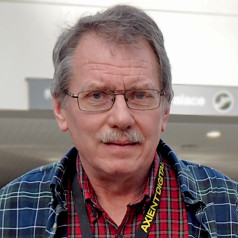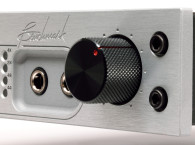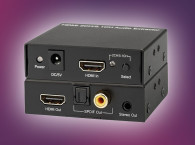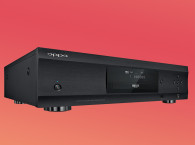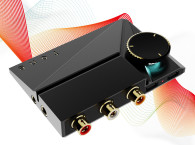
The heart of Benchmark’s DAC2 is ESS Technology’s ES9018 digital-to-analog converter chip, widely recognized in the industry as one of the best DAC chips and, until now, the best in the view of Benchmark’s Vice President and Director of Engineering John Siau. Although several other manufacturers of DACs and stand-alone digital players used the ES9018, Benchmark’s implementation ensured the best possible operating environment for the chip. But, ESS Technology hasn’t let grass grow under its feet. Last year, it announced a new line of audiophile-grade, 32-bit DAC chips, including the ES9028PRO (see Photo 1).


Now, Benchmark has recently introduced its DAC3 line of D/A converters based on the new ESS chip (see Photo 2). The ES9028PRO has a 64-pin footprint, and is pin-compatible with the ES9018, enabling Benchmark to drop it into the same PC board used in the DAC2. This makes the DAC3 a cost-effective upgrade. Siau notes that the DAC3 is like a DAC2 on steroids. In addition to the new ESS chip, the software and the analog gain structure are different from those in the DAC2.
Like its predecessor, the DAC3 is available in three versions—the DAC3 HGC, the DAC3 L, and the DAC3 DX. The DAC3 HGC reviewed here combines an analog preamplifier with the DAC. There are two stereo, unbalanced (RCA) analog inputs and two stereo, unbalanced analog outputs, along with one stereo balanced (XLR) analog output (see Photo 3).
All outputs can be controlled with the front-panel volume control, eliminating the need for a separate analog preamp. Digital inputs include two S/PDIF coaxial, two Toslink optical, and one USB. The USB Audio 1.1 mode supports pulse code modulation (PCM) up to 96 kHz/24-bit and doesn’t require any driver on the host computer. The USB Audio 2.0 mode requires the free, downloadable driver on Windows computers, and supports PCM up to 192 kHz/24-bit, along with DSD at 2.8224 MHz in the DoP 1.1 format.
No driver is needed for the Macintosh platform. Users who need an AES/EBU (XLR) digital input can opt for the DX version, which doesn’t include the analog inputs. The L version is an HGC without the headphone outputs.


DAC3 HGC’s Key Features
My 2015 review of the DAC2 DX is still available on the audioXpress website (see also Resources). And, since much of the technology in the DAC2s and DAC3s is the same, I’m not going to repeat all the details here. I recommend reading the DAC2 DX article as a prelude to this review. The functionality of the HGC, the DX, and the L versions is essentially the same for the DAC2s and the DAC3s, and is also covered in the DAC2 DX review.
Here’s a short list of the key features and technologies that the DAC3 HGC converter has inherited from the DAC2 HGC:
• Hybrid Gain Control (HGC) combining analog and 32-bit digital volume controls for the lowest possible noise floor
• Native Direct-Stream Digital (DSD) conversion
• Advanced USB input using an SMSC USB3318 high-speed USB transceiver and an XMOS programmable microcontroller. Benchmark’s Multi-Mode Asynchronous Advanced USB Audio eliminates jitter-induced distortion, offering the convenience of computer playback without the usual compromises
• Texas Instruments (TI)/National LME49860 op-amps for all analog circuitry
• TI/National LME49600 high-current audio buffers on headphone outputs
• Switching-mode power supply, reducing AC line hum to -133 dB even at full output, and -160 dB at idle
• Front panel display of both sampling rate and digital word length DAC3 HGC Improvements
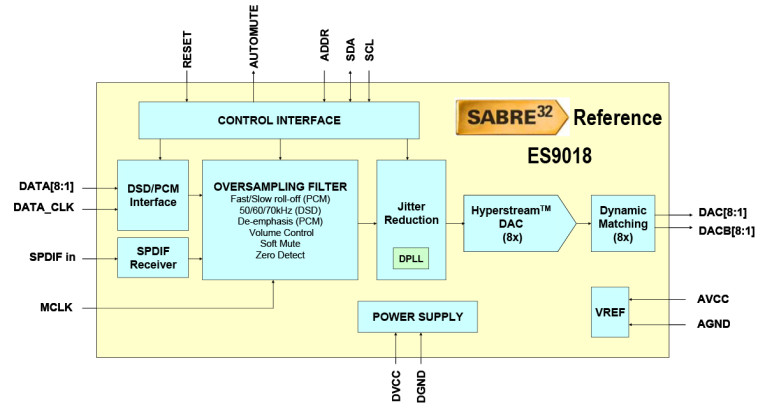
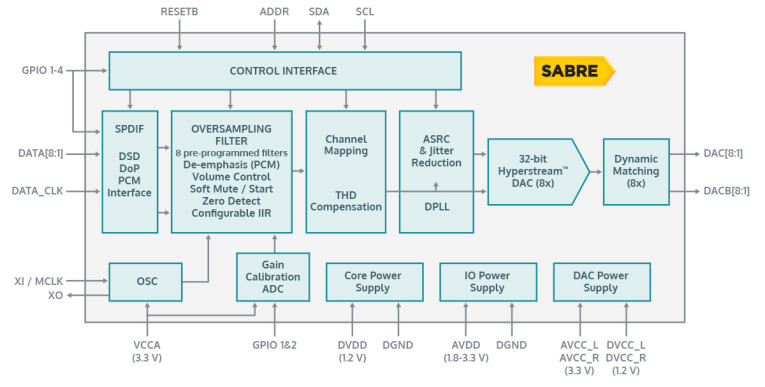
(Images courtesy of ESS Technology)
ESS’s Sabre ES9018 DAC chip is now seven years old, and Benchmark began working with the new Sabre ES9028PRO after ESS announced its new chip last October. Measurements and listening tests convinced Benchmark of the new chip’s superiority. The block diagrams for the two chips are shown in Figure 1, and reveal the ES9028PRO’s increased complexity. The ES9028PRO has four key areas of improvement over its predecessor:
• Total harmonic distortion (THD) compensation
• Improved oversampling filters
• Improved phase-locked loop (PLL)
• Improved power supply distribution
Benchmark considers the THD compensation to be the most significant improvement. The 32-bit digital processing in the ES9028PRO not only compensates for harmonic distortion at the chip’s own analog outputs, but it can also be adjusted to compensate for distortion in the post-DAC analog circuitry. The second and third harmonic distortion components can also be independently nulled. Figure 2 shows the results. The black trace shows second harmonic distortion with the DAC3 in a special test mode, with the THD compensation disabled. The results are similar to those from the DAC2. The red trace shows a significant reduction in second harmonic distortion with the THD compensation enabled. In the midrange, where the ear is most sensitive, the improvement is 8 to 12 dB.

(black) and enabled (red). The THD compensation yields a significant reduction in distortion in the critical midrange, where the ear is most sensitive. (Image courtesy of Benchmark Media Systems, Inc.)
The new ESS DAC chip offers a selection of eight digital filters, either pre-set or user-programmable. Benchmark has implemented its own linear-phase filter, optimized for the lowest passband ripple.
Like its predecessor, the DAC3 uses a TI/Burr-Brown SRC4392 sample rate converter, upsampling all digital inputs to 210.9375 kHz. This shifts the digital interpolation filter’s corner frequency out of the audio passband— above the Nyquist frequency — even for sampling frequencies of 192 kHz. Benchmark notes: “This unique Benchmark system prevents the near-Nyquist errors that would normally be produced by the filters in the D/A converter chip. The 211 kHz upsampling system allows us to implement a filter that is optimized for minimum passband ripple instead of using the default filter in the ES9028PRO. The DAC3 and DAC2 both use the Benchmark 211 kHz upsampling system, and both provide outstanding frequency-domain and time-domain performance. But, due to the improvements in the ES9028PRO, the DAC3 has slightly less passband ripple than the DAC2.”
Faster Lock Times
ESS has improved the PLL in the ES9028PRO, giving the new chip faster lock times than the ES9018. Benchmark has used this to good advantage, changing the timing in the UltraLock2 system used in the DAC2 to create UltraLock3 for the DAC3s. Jitter attenuation in the two systems is virtually identical and exceeds the performance of the PLL in the ESS DAC chips. The graphs in Figure 3 show lock times for Benchmark’s three DACs. The lock/unmute time for the DAC1 was 50 mS (see Figure 3a), but it took that converter another 2 seconds to settle. In the DAC2, the mute circuits have to be held on for 450 mS while the processor waits for the ES9018 to lock (see Figure 3b). With the ES9028PRO, the DAC3 muting time is reduced to around 6 mS (see Figure 3c). Both the DAC2 and the DAC3 are fully settled at the end of the mute cycle.

The DAC3’s faster lock and settling time makes it possible to conduct A/B comparisons between digital inputs. One obvious application would be to compare an S/PDIF coaxial interface to a Toslink optical, fed from the same digital player. The DAC3 remote control will then enable seamless switching between the two inputs without leaving your listening chair. You can even compare the analog outputs of your digital player as a stand-alone unit, to the DAC3 conversion. However, this comparison won’t be meaningful unless the analog output levels of the digital player and the DAC3 are matched.
Optimum Operating Environment
Although many stand-alone digital players and outboard DACs have used the ESS chips, Benchmark correctly notes that the chip alone is no predictor of performance. The operating environment for the DAC chip is critical and varies widely from one manufacturer to another. As with the DAC2, Benchmark has taken the necessary steps to insure the best possible performance from the ES9028PRO chip. These include:
• 4:1 channel summing, improving the signal-to-noise ratio (SNR) by 6 dB
• External current-to-voltage (I/V) converters, lowering noise and distortion
• Precision differential amplifiers, which remove common-mode distortion
• Advanced power-supply filtering, with very low-noise voltage regulation (Benchmark’s discrete design reduces noise and distortion)
• UtraLock3 jitter attenuation, providing virtually perfect jitter rejection, reducing jitter-induced sidebands to -149 dB
• 211 kHz upsampling, eliminating time-domain errors caused by the DAC chip
• DSP with 3.5 dB of headroom above 0 dB, eliminating clipping of intersample peaks
• Six-layer circuit board with external ground planes, reducing noise and providing RF shielding
ESS also introduced two other DAC chips last year — the ES9038PRO and the ES9026PRO. The ES9026PRO is a drop-in replacement for the previous-generation ES9016S. Like its predecessor, the ES9026PRO is manufactured in a 48-pin package and offers a simpler implementation, albeit with slightly lower dynamic range (124 dB vs. 129 dB for the ES9028PRO), and somewhat higher distortion (-110 dB vs. -120 dB for the ES9028PRO). But, the real confusion is in trying to decipher the differences between the ES9028PRO and the ES9038PRO. ESS calls the ES9038PRO the flagship of the ESS PRO series, claiming a dynamic range of “up to” 140 dB, and THD+N of -122 dB.
The fine print in ESS’s Product Brief for the ES9038PRO notes that 140 dB of dynamic range is in the mono mode, presumably with all eight channels connected in parallel. I contacted them for clarification on this and received a reply from Shawn Scarlett, Marketing Director for ESS. He notes that the two chips have the same circuitry. But, the ES9038PRO has “significant portions in parallel for each channel” to optimize noise performance. He further notes that “when customers use the part in stereo mode—they are creating a massively parallel system.”
ESS’s Product Brief states that the ES9038PRO “was designed for premium home-theater equipment including Blu-ray players, preamplifiers, all-in-one A/V receivers, and more.” This makes sense. If a single ES9028PRO is used in a 7.1-channel system, only one DAC section is available for each of the eight outputs. The ES9038PRO enables designers of multi-channel equipment to take advantage of the performance improvements of paralleled DACs, with a single DAC chip, just as stereo designers are able to do with the ES9028PRO.
Nonetheless, there are already stereo DACs available that use the ES9038PRO, some for substantially less money than the DAC3 HGC. One, from a company I respect, claims both a dynamic range and SNR of 120 dB. But, the Benchmark DAC3 HGC achieves a 126 dB unweighted dynamic range and S/N figure using the ES9028PRO. As noted above, a manufacturer’s implementation of a DAC chip is as important as the chip itself. Benchmark has provided a state-of-the-art operating environment for the ES9028PRO chip. As such, the DAC3 HGC can almost be guaranteed to outperform less expensive products using either of the new ESS chips, where the implementation lacks the level of sophistication found in the DAC3 HGC.
Digital Cables
Although Benchmark’s UltraLock3 jitter suppression system is arguably the most advanced in the industry, I still recommend using good quality digital interconnect cables. I use several DH Labs cables, including the Mirage USB and the Glass Master Toslink (see Photo 4). The Glass Master Toslink cable is manufactured with 300 strands of high-purity glass fibers to yield extremely wide bandwidth. The glass fibers are terminated with a machined connectors and precision polished optical grade lenses for low jitter. My own listening has shown that this cable narrows the gap between coaxial S/PDIF and Toslink more than any other Toslink cable I’ve used.
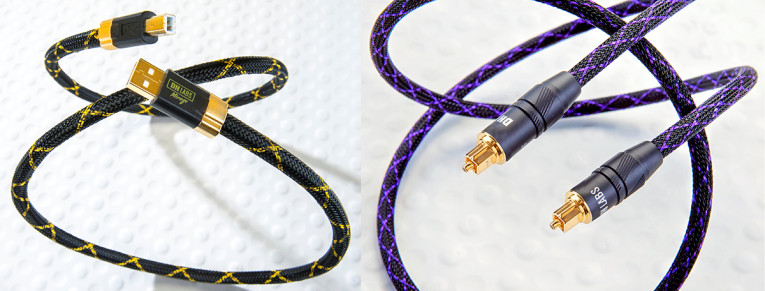
(Photos courtesy of DH Labs)
With this cable, the biggest limitations in the Toslink interface are probably the transmitter and the receiver modules used in the connected equipment. Although the Toslink interface will often operate without glitches at 192 kHz, sound quality audibly degrades above 96 kHz. Benchmark, like other manufacturers offering Toslink interfacing, specifies 96 kHz as the maximum sampling frequency supported by its Toslink inputs.
DH Labs’ Mirage USB cable is manufactured with separate shielding for the data and the power supply lines. Each line is double-shielded, making a total of four shields. The cable uses silver-plated, continuous-crystal conductors and a low-density dielectric. DH Labs claims uniform impedance, minimizing reflections, which is critical at the high sampling rates used in high-resolution digital audio.
The Mirage USB is the most transparent USB cable I’ve heard. The Glass Master Toslink and the Mirage USB are priced at $200 each for 1 m lengths. If this exceeds your budget, try the Deluxe Toslink Optical at $45 or the Silver Sonic USB at $70. On a high resolution system, these will still yield a worthwhile improvement over generic cables.
Listening
My evaluations of the DAC3 HGC were done using my OPPO Digital BDP-105 Universal Digital Player (which I reviewed in a 2013 article, see Resources) as the source for CDs, DVD-Audio, and Blu-ray audio discs and my Samsung Galaxy Note 4 with USB Audio Player Pro software for playing high-resolution media files via USB.
The HDMI 2 output of the OPPO Digital BDP-105 player feeds a KanexPro HAECOAX audio de-embedder, which is powered by my own outboard 5 V linear, regulated supply. The Kanex (which I reviewed in a 2016 article, see Resources) ensures that high-resolution DVD-Audio and Blu-ray audio discs are passed to the DAC3 HGC’s S/PDIF input at their native sampling rate. The OPPO Digital player’s own S/PDIF output is down-sampled to 44.1 or 48 kHz, when instructed to do so by the DVD or Blu-ray media. I used a Pangea HD-24PCE HDMI cable from the OPPO Digital player to the KanexPro, and DH Labs D-75 coaxial, fitted with Canare 75Ω RCA connectors, from the KanexPro to the DAC (the D-75 has been replaced with D-750).
Since last year, my reference DAC has been the DAC2 HGC, so making comparisons between the two was very easy. The DAC’s balanced outputs feed a pair of Benchmark AHB2 power amplifiers, one for each channel. (See Resources for information about my 2015 audioXpress AHB2 power amplifier review.) The AHB2 amplifiers power my Audio Concepts Sapphire III/Sub-1 loudspeaker systems in a passive bi-amp configuration. Between the feedforward error correction in the AHB2 and the THD compensation in the DAC3 HGC, this combination might yield the lowest measureable THD and noise of any digital playback system.
The DAC3 HGC retains all the virtues of its predecessor, including its remarkable transparency and a seemingly non-existent noise floor. There’s also a sense of effortlessness and a complete lack of strain even on the most complex musical scores. But, the most obvious areas of improvement are in the reproduction of inner detail and soundstage delineation.
In my 2016 review of the $10,000 Bricasti M1 Special Edition (see Resources), I noted that what set this DAC apart from others is how it “reproduces the acoustic space between individual instruments and sections of a symphony orchestra. The musicians are connected by that space with an uncanny level of
realism.” That’s what I’m hearing in the Benchmark DAC3 HGC compared to the DAC2.
By better delineating the acoustic space in which the musicians perform, localization of the musicians is rendered with greater dimensionality, which adds to the impression of greater detail. The bass performance is also improved, mainly in resolution and control. On Reference Recordings’ 176.4 kHz/24-bit files of Igor Stravinsky’s Song of the Nightingale (RR-70), the delineation of the various bass drum attacks is noticeably improved. It’s not just a matter of changes in volume, but also the subtle differences in timbre and weight.
A smartphone is a convenient method for media file playback, although there are certainly more exotic and more expensive ways of playing high resolution files. The results are not quite as smooth and detailed in the treble as DVD-Audio discs made from the same files, with the OPPO Digital BDP-105 feeding the DAC3. But, the smartphone via USB is very good, nonetheless.
HDtracks is now selling the DSD files that were used to master the RCA Victor Living Stereo SACDs made by Analogue Productions. The DSD files for the Reiner/Chicago Symphony recording of Béla Bartók’s Concerto for Orchestra are more richly textured and three-dimensional than the SACD played on the OPPO Digital BDP-105 as a stand-alone player (the OPPO Digital BDP-105 must be used as a standalone player for native DSD conversion of SACDs).
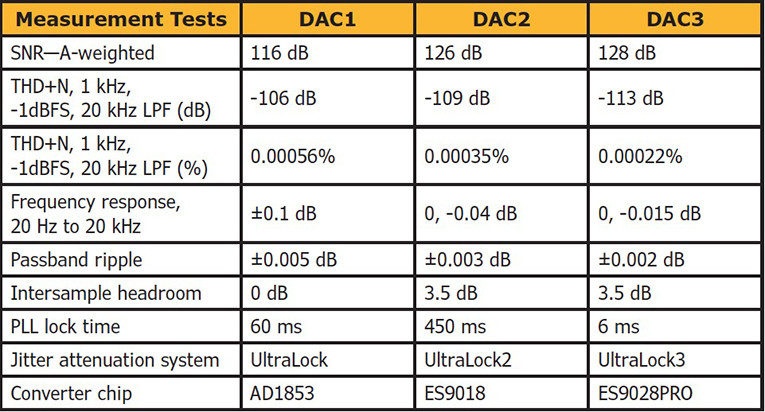
At this level of quality, we’re often splitting hairs when comparing the best DACs on the market (see Table 1). Some might be described as leaning toward ambience and warmth, while others appear more analytical. The improvements I’ve observed in the new DAC3 HGC are consistent with Benchmark’s design philosophy of making the most accurate, transparent equipment possible. What the DAC3 does is simply extract more of the information already on recordings. The improvements are readily audible on both CDs and high-resolution sources, and the end result is as warm and as musical as the source—no more and no less.
Benchmark has an interesting application note on its website titled “How Should I Buy an Audio System?,” which delves into the issue of euphonic coloration vs. transparency. Its author, John Siau, acknowledges that one piece of euphonic equipment in an otherwise transparent chain may be desirable to some listeners. But, the end result, however pleasing and musical, can’t be described as totally transparent.
Many of my reference recordings are digital remasterings of early stereophonic material from the mid-1950s through the mid-1960s, from labels including Mercury Living Presence, RCA Victor Living Stereo, and British Decca (formerly called London Decca in the US and Japan). Though these recordings captured many outstanding performances in superb sound, I admit that these recordings also have some euphonic coloration from the analog tape and tube electronics. I prefer to play them on a transparent system, so I can hear an accurate reproduction of those recordings — the DAC3 HGC/AHB2 combination provides that.
With the DAC3 HGC, Benchmark has taken an already remarkable product and moved it to the next level. The performance improvements over the DAC2 HGC are well worth the relatively modest increase in cost, and Benchmark’s DX and L versions offer the same performance upgrades in configurations to suit a variety of audio enthusiast and professional needs. The DAC3 HGC ensures Benchmark Media’s continued leadership in high resolution digital audio, and I highly recommend DAC3 HGC. ax
Resources
G. Galo, “Benchmark DAC2 DX Stereo D/A Converter,” audioXpress
www.audioxpress.com/article/Fresh-from-the-Bench-Benchmark-DAC2-DX-Stereo-D-A-Converter.
———, “Bricasti Design M1 Dual Mono D/A Converter—Deluxe Limited Edition,” audioXpress, October 2016.
———, “KanexPro HAECOAX HDMI Audio De-Embedder,” audioXpress, July 2016.
———, “Benchmark AHB2 Stereo Power Amplifier,” audioXpress, April 2015.
———, “OPPO Digital’s New 3-D Blu-ray Disc Player Raises the Bar” (BDP-105), audioXpress, October 2013.
———, “OPPO BDP-95 Universal Network Blu-ray Disc Player,” audioXpress, January 2012.
J. Siau, “How Should I Buy an Audio System?” Application Note, Benchmark Media Systems, Inc., https://benchmarkmedia.com/blogs/application_notes/124929287-how-should-i-buy-an-audio-system
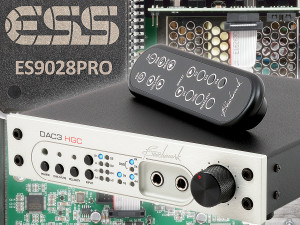 Sources
SourcesAHB2 Power amplifiers
Benchmark Media Systems, Inc. | www.benchmarkmedia.com
RCA connectors
Canare Corp. of America | www.canare.com
Mirage USB and Glass Master Toslink optical cables
DH Labs | www.silversonic.com/docs/products/USB.html
ES9018 and ES9028PRO DAC chips
ESS Technology, Inc. | www.esstech .com
USB Audio Player Pro V. 3.4.4 for Android 4.0 and up
Google Play Store | play.google.com
High-Resolution PCM and DSD files
HDtracks | www.hdtracks.com
HAECOAX audio embedder
KanexPro | www.kanexpro.com
BDP-105 Universal Digital Player
OPPO Digital | www.oppodigital.com
HD-24PCE HDMI Cable
Pangea | Audio Advisor, www.audioadvisor.com/pangea
High-Resolution files and discs
Reference Recordings | referencerecordings.com
Editor’s Note: All audioXpress articles from 2001 to present can be found on the aX Cache, a USB drive available from www.cc-webshop.com.
About the Author
Gary Galo retired in 2014 after 38 years as Audio Engineer at The Crane School of Music, SUNY at Potsdam, NY. He now works as a volunteer in the Crane Recording Archive doing preservation, restoration, and digital transfer of vintage Crane recordings. He is also a Crane alumnus, having received a BM in Music Education in 1973 and an MA in Music History and Literature in 1974. Gary is a widely-published author with more than 300 articles and reviews on both musical and technical subjects, in over a dozen publications. Gary has been writing for audioXpress and its predecessors since the early 1980s. He has been an active member of the Association for Recorded Sound Collections (ARSC) since 1989, and a frequent recording and book reviewer for the ARSC Journal. He has given numerous presentations at ARSC annual conferences, many of which have been published in the ARSC Journal. He was the Sound Recording Review Editor of the ARSC Journal from 1995-2012, and co-chair of the ARSC Technical committee from 1996-2014. Gary has also published numerous book reviews in Notes: Quarterly Journal of the Music Library Association, written for the Newsletter of the Wilhelm Furtwängler Society of America, Toccata: Journal of the Leopold Stokowski Society, and he is the author of the “Loudspeaker” entry in The Encyclopedia of Recorded Sound in the US. He has also written several articles for Linear Audio. He is a member of the Audio Engineering Society, the Boston Audio Society, and the Société Wilhelm Furtwängler.
This article was originally published in audioXpress, July 2017.


